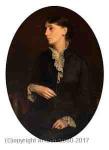Fidelia Bridges
Fidelia Bridges
Place: Salem
Born: 1834
Death: 1923
Biography:
Fidelia Bridges was one of the small number of successful female artists in the 19th and early 20th centuries. She was a painter and illustrator, capturing small aspects of nature: flowers, birds, and other plants in their natural settings. She first was an oil painter and later took up watercolor painting. She was known for her delicately detailed paintings. She was considered a watercolor expert and specialist. She was the only woman in the group of seven notable 19th-century artists in the American Watercolor Society. Her illustrations were published in books, magazines and were used for greeting cards.
Fidelia Bridges was born in Salem, Massachusetts, to a sea captain, Henry Gardiner Bridges (1789-1849) and his wife Eliza Chadwick Bridges (1791-1850). She was orphaned by age fifteen after her mother and father died. Henry Bridges was taken ill and was taken to Portuguese Macau, where he died in December, 1849. Three months later, just three hours before the news of his death arrived in Salem, Eliza died in March, 1850.
The couple left four children, Eliza, Elizabeth, Fidelia and Henry who lived at 100 Essex Street, now known as the Fidelia Bridges Guest House, but moved to a more affordable home on the same street after their parent's death. Fidelia's older sister, Eliza, was a school teacher and became the guardian of her younger siblings.
Fidelia, who was ill, was taken to Virginia Springs with family friends and upon her return studied drawing during her convalescence in Salem. She became friends of artist and art school owner, Anne Whitney. Having regained her health, Fidelia became a live-in mother's helper in the household of William Augustus Brown, a Quaker who had been a Salem ship-holder and the moved to Brooklyn, New York, where he became a successful wholesale produce merchant. The Bridges moved to Brooklyn, too, and in 1854 Eliza established a school there. Eliza died in 1856 of tuberculosis and Fidelia and her older sister Elizabeth then ran the school.
Bridges, however, soon abandoned teaching in order to concentrate on her drawing lessons. In 1860, after being inspired by sculptress Anne Whitney, she enrolled at the Pennsylvania Academy of the Fine Arts in Philadelphia with William Trost Richards and became very close to his family. By 1862, she had her own studio in downtown Philadelphia. Having remained friends with the Richards family, she accompanied them to Lake George and Lehigh Valley of Pennsylvania and New Jersey on sketching trips. He was a Pre-Raphaelite advocate and her style was greatly influenced by him. Mr. Richards says of Miss Bridges' work "(the best of the kind he knows) that it is the unaffected expression of a great joy in the beauty of nature—a joy which is after all the fountain of all that is finest in art; and one could not see the rich treasures of Miss Bridge's portfolios of studies without feeling this."
Through Richards, Bridges met museum curators and patrons of the arts, several of whom became collectors of her paintings. She exhibited her works at the Pennsylvania Academy of Fine Arts.
In 1865, Bridges left Philadelphia and established a studio on the top floor of the Brown's house in Brooklyn, where Anne Whitney worked and lived with her companion Adeline Manning, a painter from Boston.
After the American Civil War she studied for a year in Rome and lived and traveled with Adeline Manning and Anne Whitney. She maintained her style of intricate botanical works in oil. Bridges returned to the United States in the fall of 1868. Her works were then exhibited at the National Academy of Design. In 1871, watercolor was a respected medium and she quickly gained popularity with her watercolor depictions of flowers and birds. Her pictures, however, were not mere photographic reproductions of what she saw; with the imagination of the true artist, she infused her subjects with a deep poetic meaning. Bridges "combined the temper of romanticism with the technique of a scientist," according to Frederick Sharf's biography of her.
Bridges was considered a specialist in her field and focused on the beauty and serenity of microscopic details in nature. One of her favored sites was Stratford, Connecticut, where she enjoyed the wildflowers and other subject matter in the area's flats and meadows. The birds found in the green salt grass lined banks of the Housatonic River were also of interest. She made some of her best paintings of the scenes from her summer visits from 1871 to 1888 with Oliver Ingraham Lay and his family. Paintings such as Daisies and Clover and Thrush in Wild Flowers are examples of her works during this period. She lived in Stratford, Connecticut by 1890 when she ministered to the ailing Lay who died that year.
She was elected as a National Academy of Design associate in 1873 and one year later became the only woman of seven artists in the American Society of Painters in Watercolor (now The American Watercolor Society). She exhibited her work sporadically from 1863 until 1908.
More...
Wikipedia link: Click Here








